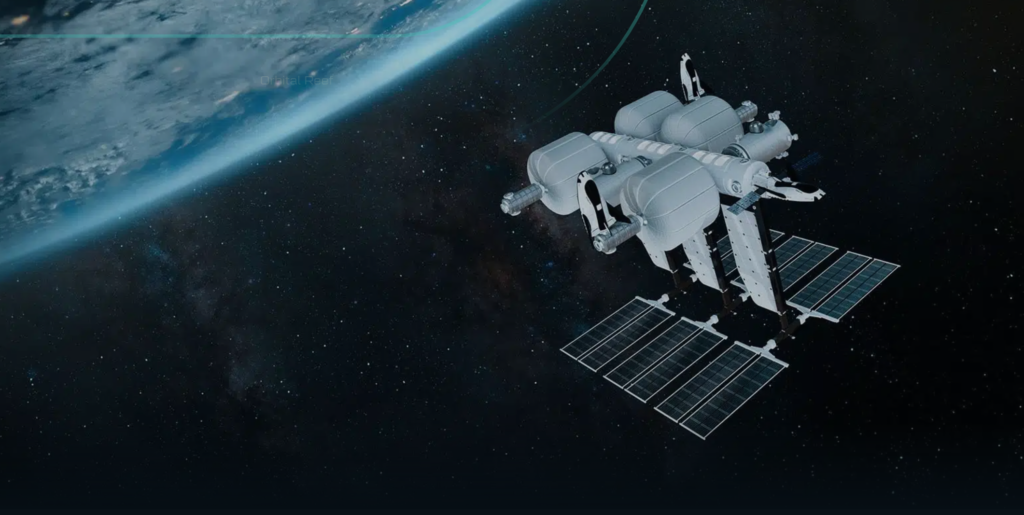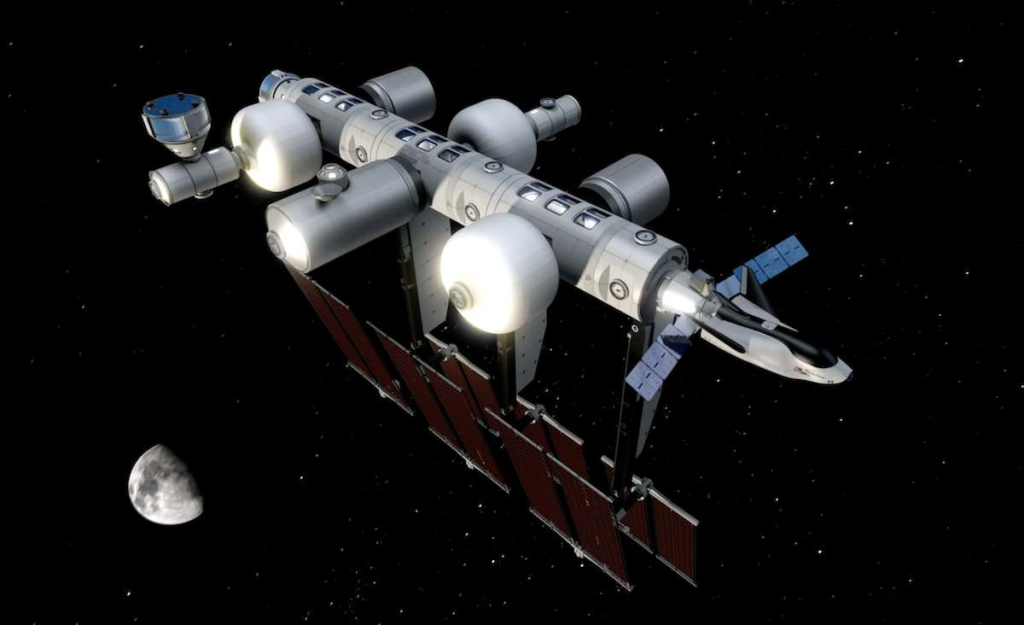
A Closer Look At Orbital Reef & What It Has To Offer
Right now the space industry is busier than ever with different companies all working on unique and ambitious goals. While the majority of progress is being made regarding launch vehicles and accessing space, there is another market continuing to grow that revolves around space destinations. One primary example is Orbital Reef, led by Blue Origin and Sierra Space.
For over a year now these two companies along with a few other contributors, have been in the development phase of this station. The goal is to create a mixed use business park and space in low Earth orbit within the next couple of years. In order for this project to become a reality, a lot of projects need to perform as expected including New Glenn, Dream Chaser, the LIFE Habitat, and more.
Just a few delays from a single project can have a ripple effect on larger goals such as this station. Something that Blue Origin and Sierra Space are trying to avoid. Here I will go more in-depth into Orbital Reef’s current status, whether or not the expected finish date is within reach, how various projects impact its future, and more.
Orbital Reef Progress

Orbital Reef is trying to become the premier mixed-use space station in low Earth orbit for commerce, research, and tourism by the end of this decade. In total there are 6 main contributors working together on this station. The first is Blue Origin, providing utility systems, large-diameter core modules, and the reusable heavy-lift New Glenn launch system. Next is Sierra Space, responsible for the Large Integrated Flexible Environment (LIFE) module, node module, and Dream Chaser spaceplane. The other patterns include Boeing, Redwire Space, Genesis Engineering Solutions, and Arizona State University.
Of these various projects and companies involved, Sierra Space and Blue Origin are responsible for the most vital infrastructure with New Glenn, Dream Chaser, and the LIFE Habitat topping the list. While the overall completion date is toward the end of this decade, the company has specifically stated that the station should be operational by 2027. This timeframe may seem far away but in reality, it’s not at all.
Starting with Blue Origin, they are targeting 2024 for the first launch of New Glenn, however, a more realistic estimate would be later in 2025 as New Glenn still has a lot of work and testing necessary prior. Even this schedule is quite aggressive based on the development and testing that still needs to be completed. Not to mention the fact that problems could easily arise with this heavy lift launch vehicle. It doesn’t help that Blue Origin is making the jump from New Shepard to New Glenn. The difference between these rockets cannot be understated and will no doubt have an impact on New Glenn’s development and testing speed. On the bright side, as I speak Vulcan with its two newly installed BE-4 engines is on a boat to ULA’s launch site in the Cape. The first flight of these engines will provide some invaluable data to Blue Origin and help with the future integration of these engines onto New Glenn.
Shifting our focus to Sierra Space, some similar concerns arise. Before the end of this year, the uncrewed Dream Chaser named Tenacity is set to launch. This being said, for Orbital Reef, Sierra Space is expected to provide both the crewed and uncrewed Dream Chaser variants. We can safely say that the uncrewed variant will be ready well before that timeframe, but it’s much harder to approve crewed missions. In November 2021, Sierra Nevada Corporation reported that it received a $1.4 billion investment in Series A funding, which it will use to develop a crewed version of Dream Chaser and fly astronauts by 2025.
It’s important to point out that in this specific case, there are other options. Boeing for example is responsible for providing additional crew transportation with Starliner which is ready. The other main contribution to look out for is the LIFE Habitat. Out of practically all the projects necessary for this station, LIFE is making some of the best progress. The company just completed another scale ultimate burst pressure test that delivered good results. Full-scale LIFE UBP tests will begin this year, in order to complete NASA’s certification of the habitat’s primary structure for human use in space. From here we will see future tests in space and eventually completion of this project.
Station Development

Now that we know more about some of the contributions that are most important and the progress they’ve made, we can take a closer look at the purpose of this station and its development. Only months after being announced, Orbital Reef was selected by NASA for a funded Space Act Agreement for collaboration to design a commercially owned and operated space station in low Earth orbit (LEO). NASA’s Commercial LEO Development program aims to shift NASA’s research and exploration activities in LEO to commercial space stations, helping stimulate a growing space economy before the International Space Station is retired.
Just three months later, the team completed its Systems Requirements Review (SRR). The SRR is an important program milestone marking the baselining of the requirements for the mission and design of Orbital Reef. Specifically, the SRR reviewed Orbital Reef specifications to ensure they reflect the current knowledge of the mission and market requirements to serve as a stable baseline to proceed with development. The review assessed Orbital Reef’s ability to meet safety and mission requirements and evaluated the technical readiness of the design, the concept of operations, the feasibility of project development plans, and planned verification activities.
This leads us to the most recent update in August of last year. Here they successfully completed the System Definition Review (SDR) with NASA. The SDR is another program milestone to establish the functional baseline for Orbital Reef. It demonstrated to NASA that the space station design is feasible and achievable while validating that the Orbital Reef system is on-track to proceed into the design phase. The SDR included an extensive review to ensure that the proposed Orbital Reef architecture is responsive to the functional and performance requirements; it examined the proposed system architecture and the flowdown to all functional elements of the Orbital Reef system. The successful SDR supported NASA’s decision to further develop the system architecture and design.
“This SDR moves Orbital Reef forward,” said Brent Sherwood, Senior Vice President of Advanced Development Programs at Blue Origin. “We are meeting the needs of both the commercial marketplace and NASA’s requirements. Orbital Reef will change the game for human space flight in Earth orbit.” Orbital Reef will continuously orbit the planet approximately 250 miles above Earth. The goal being, now anyone can lease access to the space environment – weightlessness, hard vacuum, remote views of Earth – to further groundbreaking research, technology development, and manufacturing of innovative products. The company highlights that whether the business is scientific research, exploration system development, invention and manufacture of new and unique products, or media and advertising; customers can establish their address in orbit.
The plan is to provide end-to-end service: transportation and logistics, leased space for any purpose, assistance with system hardware development, robotic and crew-tended operations and servicing, and habitation amenities. Experienced customers can simply link up their own modules through standard interfaces. On Orbital Reef, shared infrastructure supports the proprietary needs of tenants and visitors. The company is quoted saying, “This business model – traditional on Earth but unprecedented in space – lowers barriers for all customers and promotes competitive development of space applications. The Baseline configuration has separate science and habitation zones and supports 10 people in a volume almost as large as the International Space Station (ISS). Scalable by design, total volume can easily expand as needed to support growing customers and needs.”
It’s important to point out that Blue Origin and Sierra Space are not the only companies working on a commercial space station. The construction of Axiom’s first commercial space station is underway. Following the completion of preliminary and critical design reviews in collaboration with NASA, their partners at Thales Alenia Space began welding and machining activities for the primary structures of Axiom Station’s first module. The first pieces of fabricated flight hardware are beginning to come together, and the assembled module will join them in Houston soon where they will complete final assembly and integration. Axiom Space is preparing for a late 2025 launch of the first section of its next-generation platform that will operate in low-Earth orbit. Not to mention, Axiom Space is the only company with the privilege of connecting its modules to the International Space Station. An important benefit that Orbital Reef does not have.
Conclusion
Orbital Reef is scheduled to be operational in only a few years from now. Between then and now, companies such as Blue Origin and Sierra Space need to complete projects including New Glenn, the crewed Dream Chaser variant, and more. With so many different projects involved, a few delays on one could have an even bigger impact on the future of this station and when it’s complete. We will have to wait and see how it progresses and the impact it has on the space industry.
